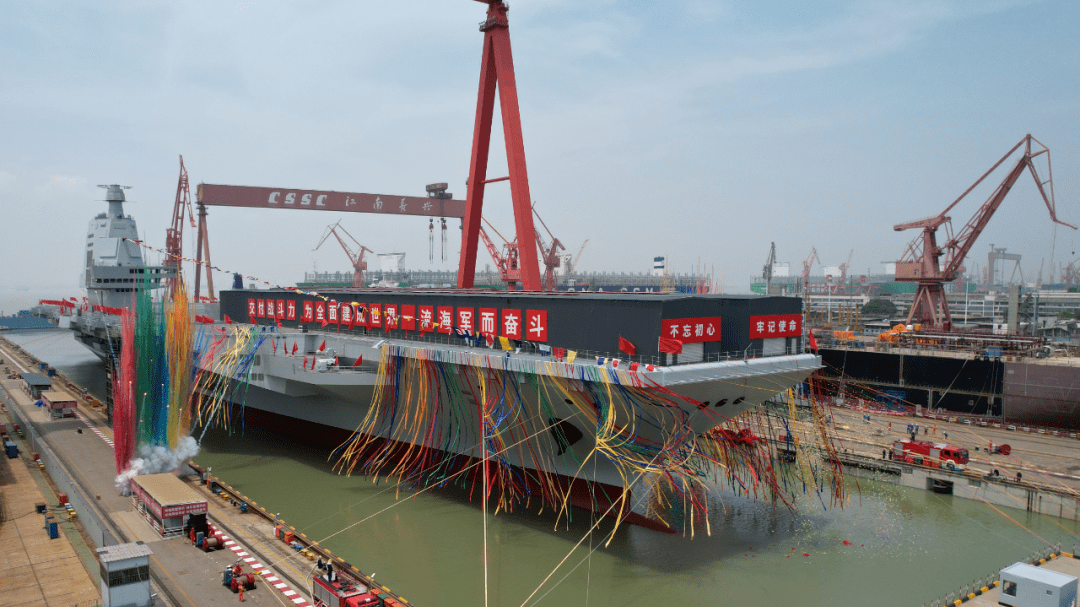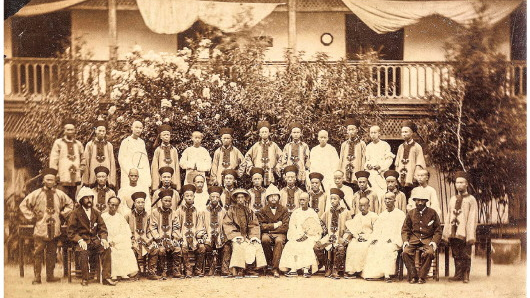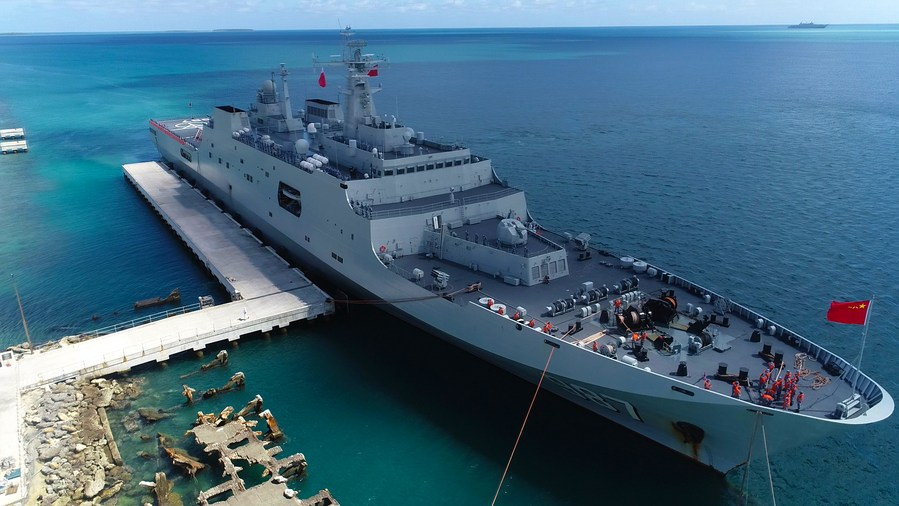
The launch ceremony for China's third aircraft carrier christened Fujian at a dry dock in Shanghai on Friday, June 17, 2022. /Xinhua via AP
The launch ceremony for China's third aircraft carrier christened Fujian at a dry dock in Shanghai on Friday, June 17, 2022. /Xinhua via AP
China's third aircraft carrier left its drydock at Jiangnan shipyard outside Shanghai in June, marking the latest milestone of the modernization of the People's Liberation Army Navy (PLAN).
The new-generation carrier, the first both designed and built indigenously, was named after Fujian Province on the southeastern coast of China, following the tradition of naming the first two carriers after the provinces of Liaoning and Shandong.
Weighing around 100,000 tonnes when fully loaded, the Fujian will join Liaoning (Type 001) and Shandong (Type 002), which were commissioned in 2012 and 2019, respectively. Both carriers employ the "ski-jump" launch method for aircraft, with a ramp at the end of the short runway to help fixed-wing aircraft take off.
Compared with its two predecessors, the Type 003 carrier Fujian is a leap in capabilities from older models. With a larger flight deck and a smaller superstructure, it is equipped with three electromagnetically powered catapults, also called Electromagnetic Aircraft Launch System (EMALS), rather than a ski ramp.
EMALS is the navy's newest complete carrier-based launch system, which accelerates aircraft taking off at speed. It also enables a carrier to launch a broader variety of aircraft, especially those with heavier payloads.

A satellite image of China's Type 003 aircraft carrier under construction at a shipyard northeast of Shanghai, May 21, 2022. Planet Labs PBC via AP
A satellite image of China's Type 003 aircraft carrier under construction at a shipyard northeast of Shanghai, May 21, 2022. Planet Labs PBC via AP
When did modern warship building get started?
It wasn't long before the Chinese started building modern warships. In 1866, spearheaded by governors-general Li Hongzhang and Zuo Zongtang, the Qing government cooperated with France to establish Foochow Arsenal in Fuzhou, the capital of Fujian. During the second half of the nineteenth century, the port region Fujian was at the frontier in the confrontation with Western imperialism.
The Foochow Arsenal was one of the shipyards created by the Qing government during the Self-Strengthening Movement from the 1860s to the 1890s. As the first attempt to study from the West, it aimed to build a modern navy and train modern naval officers. French engineers and craftsmen were hired, and schools for naval construction and apprenticeship were set up.
Although French forces severely damaged the shipyard in 1884 during the Sino-French War, it represented a series of efforts by the Qing government to strengthen its maritime force after the Opium War (1840-1842) and Arrow War (1856-1860), which facilitated the independent construction of modern warships.

The first batch of students graduated from Foochow Arsenal. / Xinhua
The first batch of students graduated from Foochow Arsenal. / Xinhua
What does navy modernization mean for China?
Since the People's Republic of China was founded in 1949, it began to view the maritime force as an increasingly critical component of the national security structure. The PLAN has purchased military hardware from abroad since the late 1990s, upgraded the aging ships, and built naval platforms.
The development of the Type 003 carrier is part of a broader modernization of China's military. It aligns with the country's growing emphasis on the maritime domain and the demands for the PLAN to operate at greater distances from China. With the development of the Chinese economy, the navy plays an increasingly important role in sea lines of communication.
With the modernization efforts, China's navy has transformed into a modern and capable force, composed of modern multi-role platforms with advanced weapons and sensors.
"It has only been nearly a hundred years since the appearance of the first aircraft carrier, but it is a revolutionary leap in maritime warfare from the battleship era of cannon ship," said Huang Pumin, a former researcher at the Department of Strategic Studies at the PLA Academy of Military Science.
As the backbone of the navy's strength, the aircraft carrier has been playing an essential role in winning decisive naval battles since the 1940s, including the Battle of Taranto and Battle of Midway. For China, its significance lies in maintaining the security of its global sea lines of communication and the security of overseas interests.
According to the white paper titled "China's National Defense in the New Era" released by the State Council Information Office in 2019, China's military is a "staunch force for world peace, stability and the building of a community with a shared future for mankind."

Aerial photo shows a flotilla of the People's Liberation Army (PLA) Navy carrying relief supplies arriving in Nuku'alofa, Tonga, February 15, 2022. /Xinhua
Aerial photo shows a flotilla of the People's Liberation Army (PLA) Navy carrying relief supplies arriving in Nuku'alofa, Tonga, February 15, 2022. /Xinhua
Over the past two decades, the Chinese military has been participating in humanitarian assistance and disaster relief operations outside China's borders, like earthquake rescue and relief efforts in Nepal and aid to Philippines struck by typhoon Haiyan. Earlier this year, PLA's navy and air force units were involved in the relief mission to Tonga after its devastating volcanic eruption and tsunami, delivering more than 1,400 tons of relief supplies including food, medical supplies, electricity generators and water pumps.
"To a certain extent, whether a country owns an aircraft carrier or the technical level of an aircraft carrier symbolizes a country's overall military strength and national defense capabilities," Huang, also a military history expert at the Renmin University of China, told CGTN.
"An aircraft carrier is tangible proof of the country's technological proficiencies and considered the most valuable sea-based asset. It's worth noting that the purpose of China developing aircraft carriers is to defend the country's strategic security and promote world peace," he added.

